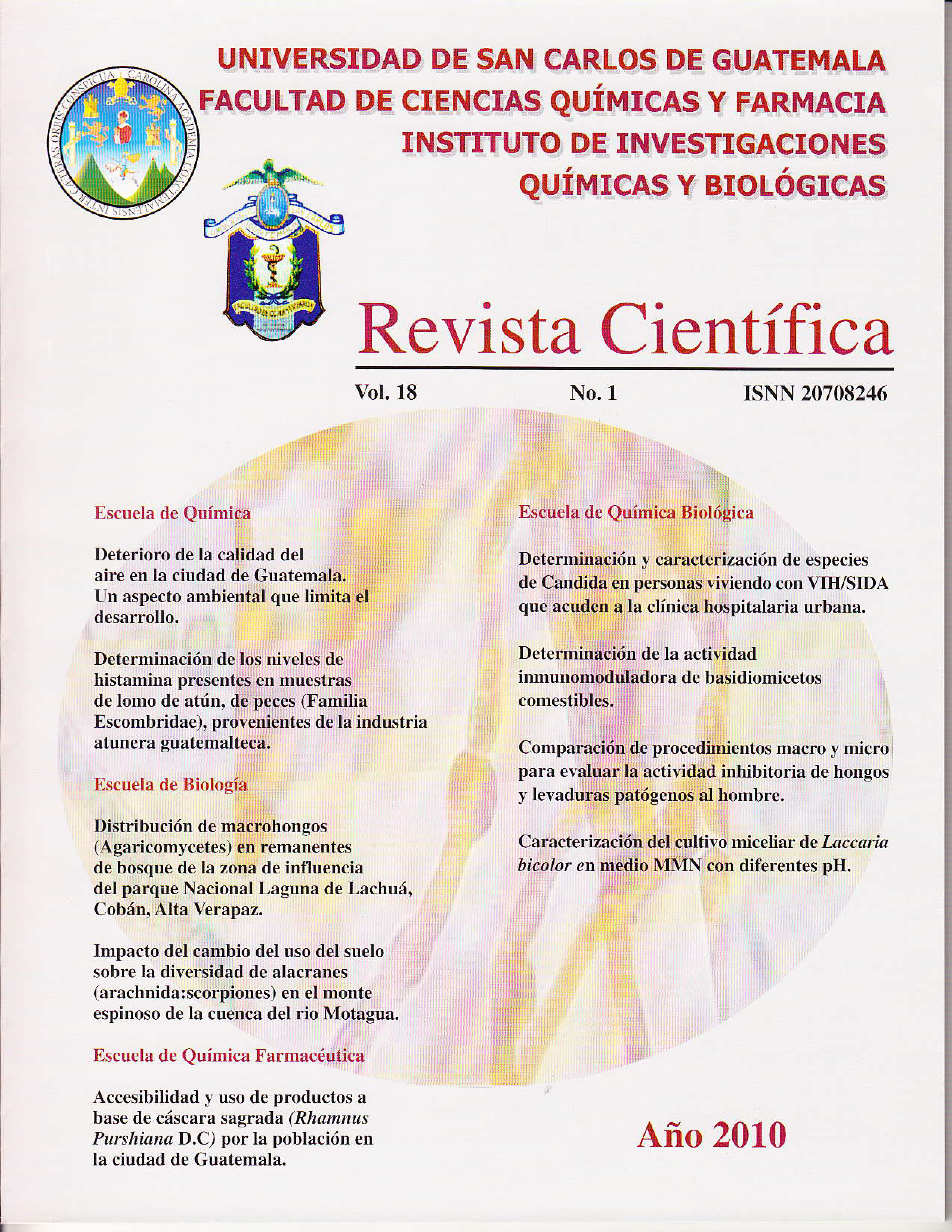Determination of histamine levels present in samples of tuna steak, fish (Family Escombridae) from Guatemala tuna industry
DOI:
https://doi.org/10.54495/Rev.Cientifica.v18i1.164Keywords:
histamine, tuna, Scombridae familyAbstract
Histamine concentration will be limited in 16 tuna loin samples, following the methodology proposed by Eerola et al. (two). Prior to the analysis, said method was evaluated in the following parameters; detection limit, quantification, linearity, precision and accuracy. The methodology is based on the extraction of histamine with perchloric acid, from a homogenized sample of tuna loin, its derivatization with dansyl chloride, detection and quantification of the derivatization product with high resolution liquid chromatography with a UV detector at 254nm. The study of the evaluation of the method is satisfactory, since it complies with the evaluating statistical parameters; presenting good repeatability, reproducibility, accuracy, linearity (r2 = 0.9997) and with detection and quantification limits (2.50 and 8.35 mg/kg respectively) that are below the permissible limit established by the European Union in Regulation (EC) No. 2073/2005 (100mg/kg), so it is demonstrated that the method is precise and exact, suitable to be used for the quantification of histamine in tuna loin. Finally, it was concluded that the concentration of histamine in the study population does not exceed this limit.
Downloads
References
Ben. G.; Craven, C.; Ann, H. 1998. “Histamine formation in albacore muscle analyzed by AOAC and enzymatic methods”. J. Food Sci. 83 (2): 210-214. https://doi.org/10.1111/j.1365-2621.1998.tb15711.x
Eerola. S,; Hinkanen, R.; Lindfords. E.; Hirvi, T. 1993 “Liquid chromatographic determination of biogenic amines in dry sausages’’. Journal of AOAC International, 76 (3): 575-577, https://doi.org/10.1093/jaoac/76.3.575
Freeman, b.a. 1988 “Microbiología de Burrows”. 22 Ed. USA. Editorial Interamericana McGraw-Hill.
Huss H.H. 1999. “Evaluación de la calidad del pescado”. Dinamarca. FAO documento Técnico de pesca 348.
Instituto de Agricultura. Recursos Naturales y Ambiente (TARNA), Universidad Rafael Landívar (URL) y Asociación Instituto de Incidencia Ambiental (HA), 2006. “Perfil Ambiental de Guatemala: tendencias y reflexiones sobre la gestión ambiental”, Guatemala, P 17-25.
Millán. R.; Izquierdo, P :Aliara, M.: et al. 2003. “Efecto de la temperatura y el tiempo de almacenamiento sobre la calidad microbiológica y la producción de histamina en la Lisa (Mugil cinema)”. Rev. Cienti. FCV-LUZ. Vol. 13, (5), 339-346.
Reglamento (CE) No. 2073/2005 de la Comisión, de 15 de noviembre de 2005. relativo a los criterios microbiológicos aplicables a los productos alimenticios. Diario Oficial de la Unión Europea. L 338 de 22. 12.2005, p. 11 - 14.
Downloads
Published
How to Cite
Issue
Section
License
Copyright (c) 2010 H. Flores, D. Pinagel

This work is licensed under a Creative Commons Attribution 4.0 International License.
Authors who publish with this journal agree to the following terms:
- Authors retain copyright and grant the journal right of first publication with the work simultaneously licensed under a Creative Commons Attribution License 4.0 that allows others to share the work with an acknowledgement of the work's authorship and initial publication in this journal.
- Authors are able to enter into separate, additional contractual arrangements for the non-exclusive distribution of the journal's published version of the work (e.g., post it to an institutional repository or publish it in a book), with an acknowledgement of its initial publication in this journal.
- Authors are permitted and encouraged to post their work online (e.g., in institutional repositories or on their website) prior to and during the submission process, as it can lead to productive exchanges, as well as earlier and greater citation of published work.









